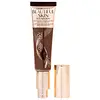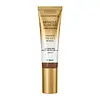What's inside
What's inside
 Key Ingredients
Key Ingredients

 Benefits
Benefits

 Concerns
Concerns

 Ingredients Side-by-side
Ingredients Side-by-side

Water
Skin ConditioningPyrus Malus Fruit Water
MaskingDimethicone
EmollientMica
Cosmetic ColorantOctyldodecyl Stearoyl Stearate
EmollientCetyl PEG/PPG-10/1 Dimethicone
EmulsifyingHydrogenated Ethylhexyl Olivate
EmollientHydrogenated Polyisobutene
EmollientPropanediol
SolventGlycerin
HumectantTrimethylsiloxysilicate
EmollientPolyglyceryl-4 Isostearate
EmulsifyingSodium Chloride
MaskingLauroyl Lysine
Skin ConditioningDimethicone/Vinyl Dimethicone Crosspolymer
Skin ConditioningDisteardimonium Hectorite
StabilisingSodium Dehydroacetate
PreservativeHydrogenated Olive Oil Unsaponifiables
EmollientCaprylyl Glycol
Emollient1,2-Hexanediol
Skin ConditioningTriethoxycaprylylsilane
Sodium Gluconate
Skin ConditioningTocopheryl Acetate
AntioxidantMaltodextrin
AbsorbentBixa Orellana Seed Extract
MaskingPentylene Glycol
Skin ConditioningButylene Glycol
HumectantCassia Angustifolia Seed Polysaccharide
Skin ConditioningSodium Hyaluronate
HumectantCocos Nucifera Fruit Extract
EmollientAluminum Hydroxide
EmollientRosa Damascena Flower Oil
MaskingRosa Damascena Flower Water
MaskingPentaerythrityl Tetra-Di-T-Butyl Hydroxyhydrocinnamate
AntioxidantCI 77891
Cosmetic ColorantIron Oxides
Water, Pyrus Malus Fruit Water, Dimethicone, Mica, Octyldodecyl Stearoyl Stearate, Cetyl PEG/PPG-10/1 Dimethicone, Hydrogenated Ethylhexyl Olivate, Hydrogenated Polyisobutene, Propanediol, Glycerin, Trimethylsiloxysilicate, Polyglyceryl-4 Isostearate, Sodium Chloride, Lauroyl Lysine, Dimethicone/Vinyl Dimethicone Crosspolymer, Disteardimonium Hectorite, Sodium Dehydroacetate, Hydrogenated Olive Oil Unsaponifiables, Caprylyl Glycol, 1,2-Hexanediol, Triethoxycaprylylsilane, Sodium Gluconate, Tocopheryl Acetate, Maltodextrin, Bixa Orellana Seed Extract, Pentylene Glycol, Butylene Glycol, Cassia Angustifolia Seed Polysaccharide, Sodium Hyaluronate, Cocos Nucifera Fruit Extract, Aluminum Hydroxide, Rosa Damascena Flower Oil, Rosa Damascena Flower Water, Pentaerythrityl Tetra-Di-T-Butyl Hydroxyhydrocinnamate, CI 77891, Iron Oxides
Water
Skin ConditioningCyclopentasiloxane
EmollientPhenyl Trimethicone
Skin ConditioningGlycerin
HumectantMica
Cosmetic ColorantCetyl PEG/PPG-10/1 Dimethicone
EmulsifyingDiisopropyl Dimer Dilinoleate
EmollientCocos Nucifera Oil
MaskingTrimethylsiloxysilicate
EmollientZinc Oxide
Cosmetic ColorantSodium Chloride
MaskingPEG-10 Dimethicone
Skin ConditioningAmmonium Acrylates Copolymer
Phenoxyethanol
PreservativeDisteardimonium Hectorite
StabilisingAlpha-Glucan Oligosaccharide
CleansingLecithin
EmollientPentylene Glycol
Skin ConditioningChlorphenesin
AntimicrobialPropylene Carbonate
SolventParfum
MaskingTocopheryl Acetate
AntioxidantIsopropyl Titanium Triisostearate
EmollientAlcohol Denat.
AntimicrobialPolymnia Sonchifolia Root Juice
Skin ConditioningAloe Barbadensis Leaf Juice
Skin ConditioningAscorbyl Glucoside
AntioxidantCitric Acid
BufferingFructose
HumectantSodium Hydroxide
BufferingUrea
BufferingDisodium Deceth-6 Sulfosuccinate
CleansingMaltodextrin
AbsorbentRetinyl Palmitate
Skin ConditioningTriethoxycaprylylsilane
Cocos Nucifera Fruit Extract
EmollientLaureth-30
CleansingPEG-60 Hydrogenated Castor Oil
EmulsifyingHexyl Cinnamal
PerfumingAllantoin
Skin ConditioningMaltose
MaskingSodium Lactate
BufferingSodium PCA
HumectantTrehalose
HumectantBenzyl Benzoate
AntimicrobialCitronellol
PerfumingLinalool
PerfumingSodium Dehydroacetate
PreservativeLactobacillus
Skin ConditioningPanthenol
Skin ConditioningTocopherol
AntioxidantCaprylyl Glycol
EmollientGlucose
HumectantSodium Hyaluronate
HumectantPhenethyl Alcohol
MaskingEugenol
PerfumingPotassium Sorbate
PreservativeSodium Benzoate
MaskingGeraniol
PerfumingSilybum Marianum Seed Extract
Skin ConditioningHelianthus Annuus Seed Oil
EmollientRosmarinus Officinalis Leaf Extract
AntimicrobialPentaerythrityl Tetra-Di-T-Butyl Hydroxyhydrocinnamate
AntioxidantPantolactone
HumectantBHT
AntioxidantLimonene
PerfumingIron Oxides
CI 77891
Cosmetic ColorantWater, Cyclopentasiloxane, Phenyl Trimethicone, Glycerin, Mica, Cetyl PEG/PPG-10/1 Dimethicone, Diisopropyl Dimer Dilinoleate, Cocos Nucifera Oil, Trimethylsiloxysilicate, Zinc Oxide, Sodium Chloride, PEG-10 Dimethicone, Ammonium Acrylates Copolymer, Phenoxyethanol, Disteardimonium Hectorite, Alpha-Glucan Oligosaccharide, Lecithin, Pentylene Glycol, Chlorphenesin, Propylene Carbonate, Parfum, Tocopheryl Acetate, Isopropyl Titanium Triisostearate, Alcohol Denat., Polymnia Sonchifolia Root Juice, Aloe Barbadensis Leaf Juice, Ascorbyl Glucoside, Citric Acid, Fructose, Sodium Hydroxide, Urea, Disodium Deceth-6 Sulfosuccinate, Maltodextrin, Retinyl Palmitate, Triethoxycaprylylsilane, Cocos Nucifera Fruit Extract, Laureth-30, PEG-60 Hydrogenated Castor Oil, Hexyl Cinnamal, Allantoin, Maltose, Sodium Lactate, Sodium PCA, Trehalose, Benzyl Benzoate, Citronellol, Linalool, Sodium Dehydroacetate, Lactobacillus, Panthenol, Tocopherol, Caprylyl Glycol, Glucose, Sodium Hyaluronate, Phenethyl Alcohol, Eugenol, Potassium Sorbate, Sodium Benzoate, Geraniol, Silybum Marianum Seed Extract, Helianthus Annuus Seed Oil, Rosmarinus Officinalis Leaf Extract, Pentaerythrityl Tetra-Di-T-Butyl Hydroxyhydrocinnamate, Pantolactone, BHT, Limonene, Iron Oxides, CI 77891
Ingredients Explained
These ingredients are found in both products.
Ingredients higher up in an ingredient list are typically present in a larger amount.
Caprylyl Glycol is a humectant and emollient, meaning it attracts and preserves moisture.
It is a common ingredient in many products, especially those designed to hydrate skin. The primary benefits are retaining moisture, skin softening, and promoting a healthy skin barrier.
Though Caprylyl Glycol is an alcohol derived from fatty acids, it is not the kind that can dry out skin.
This ingredient is also used as a preservative to extend the life of products. It has slight antimicrobial properties.
Learn more about Caprylyl GlycolThis ingredient is a high molecular weight silicone. It has emulsifying and skin conditioning properties.
Ci 77891 is a white pigment from Titanium dioxide. It is naturally found in minerals such as rutile and ilmenite.
It's main function is to add a white color to cosmetics. It can also be mixed with other colors to create different shades.
Ci 77891 is commonly found in sunscreens due to its ability to block UV rays.
Learn more about CI 77891Cocos Nucifera Fruit Extract comes from the meat of the coconut fruit. It is an emollient and skin conditioner with antioxidant properties.
Coconut fruit is naturally rich in amino acids, sugars, and nutrients including Vitamin C and small amounts of vitamin B. Malic acid can also be found in coconut fruit extract.
Disteardimonium Hectorite comes from the clay mineral named hectorite. It is used to add thickness to a product.
It can also help stabilize a product by helping to disperse other ingredients.
Hectorite is a rare, white clay mineral.
Learn more about Disteardimonium HectoriteGlycerin is already naturally found in your skin. It helps moisturize and protect your skin.
A study from 2016 found glycerin to be more effective as a humectant than AHAs and hyaluronic acid.
As a humectant, it helps the skin stay hydrated by pulling moisture to your skin. The low molecular weight of glycerin allows it to pull moisture into the deeper layers of your skin.
Hydrated skin improves your skin barrier; Your skin barrier helps protect against irritants and bacteria.
Glycerin has also been found to have antimicrobial and antiviral properties. Due to these properties, glycerin is often used in wound and burn treatments.
In cosmetics, glycerin is usually derived from plants such as soybean or palm. However, it can also be sourced from animals, such as tallow or animal fat.
This ingredient is organic, colorless, odorless, and non-toxic.
Glycerin is the name for this ingredient in American English. British English uses Glycerol/Glycerine.
Learn more about GlycerinMaltodextrin is a polysaccharide. It is derived from starch such as rice, corn, wheat, or potato starch.
In food, Maltodextrin is used to improve the texture and thicken a product. Due to its structure, it can help create a gel texture. As an emulsion stabilizer, it helps keep the ingredients in a product together.
As a polysaccharide, Maltodextrin has moisturizing properties. Polysaccharides are a type of carbohydrate. The top layer of skin uses polysaccharides to retain water, keeping the skin hydrated.
Maltodextrin is water soluble and has a sweet taste.
Learn more about MaltodextrinMica is a naturally occurring mineral used to add shimmer and color in cosmetics. It can also help improve the texture of a product or give it an opaque, white/silver color.
Serecite is the name for very fine but ragged grains of mica.
This ingredient is often coated with metal oxides like titanium dioxide. Trace amounts of heavy metals may be found in mica, but these metals are not harmful in our personal products.
Mica has been used since prehistoric times throughout the world. Ancient Egyptian, Indian, Greek, Roman, Aztec, and Chinese civilizations have used mica.
Learn more about MicaPentaerythrityl Tetra-Di-T-Butyl Hydroxyhydrocinnamate (long name, huh?) is a synthetic antioxidant.
It is used to help stabilize other antioxidants or prevent the color from changing in a product.
As an antioxidant, it helps fight free-radical molecules. Free-radical molecules are capable of damaging our cells and other genetic material. Thus, antioxidants may reduce the signs of aging.
This ingredient is oil-soluble.
Learn more about Pentaerythrityl Tetra-Di-T-Butyl HydroxyhydrocinnamatePentylene glycol is typically used within a product to thicken it. It also adds a smooth, soft, and moisturizing feel to the product. It is naturally found in plants such as sugar beets.
The hydrophilic trait of Pentylene Glycol makes it a humectant. As a humectant, Pentylene Glycol helps draw moisture from the air to your skin. This can help keep your skin hydrated.
This property also makes Pentylene Glycol a great texture enhancer. It can also help thicken or stabilize a product.
Pentylene Glycol also acts as a mild preservative and helps to keep a product microbe-free.
Some people may experience mild eye and skin irritation from Pentylene Glycol. We always recommend speaking with a professional about using this ingredient in your routine.
Pentylene Glycol has a low molecular weight and is part of the 1,2-glycol family.
Learn more about Pentylene GlycolChances are, you eat sodium chloride every day. Sodium Chloride is also known as table salt.
This ingredient has many purposes in skincare: thickener, emulsifier, and exfoliator.
You'll most likely find this ingredient in cleansers where it is used to create a gel-like texture. As an emulsifier, it also prevents ingredients from separating.
There is much debate on whether this ingredient is comedogenic. The short answer - comedogenic ratings don't tell the whole story. Learn more about comegodenic ratings here.
The concensus about this ingredient causing acne seems to be divided. Research is needed to understand if this ingredient does cause acne.
Scrubs may use salt as the primary exfoliating ingredient.
Learn more about Sodium ChlorideThis ingredient is a preservative with antimicrobial properties. It is the sodium salt of dehydroacetic acid.
It is especially effective at preventing bacterial and fungal growth in low concentrations.
Sodium Hyaluronate is hyaluronic acid's salt form. It is commonly derived from the sodium salt of hyaluronic acid.
Like hyaluronic acid, it is great at holding water and acts as a humectant. This makes it a great skin hydrating ingredient.
Sodium Hyaluronate is naturally occurring in our bodies and is mostly found in eye fluid and joints.
These are some other common types of Hyaluronic Acid:
Learn more about Sodium HyaluronateTocopheryl Acetate is AKA Vitamin E. It is an antioxidant and protects your skin from free radicals. Free radicals damage the skin by breaking down collagen.
One study found using Tocopheryl Acetate with Vitamin C decreased the number of sunburned cells.
Tocopheryl Acetate is commonly found in both skincare and dietary supplements.
Learn more about Tocopheryl AcetateTriethoxycaprylylsilane is a silicone used to bind and stabilize ingredients.
As an emulsifier, it helps prevent ingredients from separating. This can help elongate the shelf life of products.
Triethoxycaprylylsilane is often used to coat mineral sunscreens ingredients to help give a better feel. It also helps reduce oxidative stress in sunscreens.
Learn more about TriethoxycaprylylsilaneThis silicone is an emollient. Emollients create a thin film on the skin to prevent moisture from escaping.
It is not soluble in water and helps increase water-resistance in products.
According to a manufacturer, it can blend seamlessly with silicone oils, such as Cyclopentasiloxane.
Learn more about TrimethylsiloxysilicateWater. It's the most common cosmetic ingredient of all. You'll usually see it at the top of ingredient lists, meaning that it makes up the largest part of the product.
So why is it so popular? Water most often acts as a solvent - this means that it helps dissolve other ingredients into the formulation.
You'll also recognize water as that liquid we all need to stay alive. If you see this, drink a glass of water. Stay hydrated!
Learn more about WaterThis ingredient is a combination of red, black, and yellow iron oxide pigments. This combination of colors is usually found in foundation, because it results in a "skin" color.